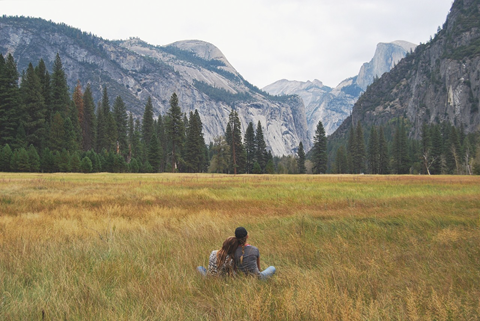Walking through the first aid aisle at your local outfitter store can be overwhelming. While there are many excellent prepared kits on the market, often enthusiasts choose to create and specialize their own. Your kit will be different based on where you are camping and hiking. Trips at altitude, near marine environments or canyoning, and desert trekking each have unique needs that would require you augment your kit accordingly.
Below is a “basic kit list,” to which you can add on as your number of adventurers, length of trip, level of training, or destination dictate. An asterisk marks items that you might include for your week-long trip. For your overnight, you can feel comfortable paring down the quantities.
Personal Protection:
- Gloves (Nitrile) – Vinyl is too porous, and latex is a common allergen. Bring a few more pair than you think you need. You use one pair of gloves each time you clean a wound, and gloves aren’t designed to be re-used. If your gloves have been in your kit for a long time, check them to make sure they didn’t degrade in heat or cold. Have these easily accessible so that you are inclined to use them when needed.
- CPR mask and airway management- you can get a quality mask with a filter for around $12. “Keychain” masks are better than nothing, but have a short life span when put to use. If you have been trained to use airway adjuncts, include some—they are a little bit of weight for a lot of good.
- Wound care (probably the most common supplies I use on trips):
- 1” athletic tape- one roll per person per week for hiking/skiing/climbing trips (really). It’s good for blister prevention, blister covering, ankle taping, and much more.
- Gauze/ dressings (4-6) – different sizes and a few nonadherent (great for burns or abrasions).
- Adhesive bandages (8)- various styles.
- Roller gauze or vet wrap (2)- something to keep the gauze next to the wound that won’t cut off circulation. Vet wrap lasts longer than roller gauze.
- Waterproof/ breathable (occlusive) wound dressings (2-3)*- an invaluable addition to wound care if you will be out for a few days. On a clean wound, this can create an environment conducive to healing that lasts a couple days. These are generally 2” x 3” or larger.
- Tweezers- invest in a good pair (sharp and pointy), which will only cost a couple dollars more than a cheap pair.
- Small magnifier- for wound cleaning. Be sure you have a reliably bright light source for wound exploration.
- Wound cleaning*- a 60cc syringe (check the local feed store) with an irrigation tip is cheap and lightweight and gives better pressure than anything we could improvise.
- Trauma shears (1)- there are some cool tiny ones (4”) on the market that only cost a few dollars and work great.
- Blister care- Moleskin, foam, gel pads, or whatever your flavor. Duct tape should not be used on open blisters.
Musculoskeletal injuries:
- Compression wrap(s)- 3” works great for supporting ankles or knees.
- Aluminum foam splint (1)
- Triangular bandages (2)- these are multi-functional.
Over the counter medications:
- Pain management- ibuprofen and acetaminophen work in different ways. Bring what you prefer, and pack a few grains of rice if you have bottles of tablets. It keeps the tablets from becoming a paste in moist conditions.
- Gastrointestinal meds*- antacids such as calcium carbonate, anti-diarrheal such as loperamide, or whatever works for you.
- Antihistamines- diphenhydramine for allergic reactions. Epinephrine injectors are prescription only and should be carried by those who require them.
- Topical antibiotic cream*- good for small, shallow wounds. No need to get a huge tube, and beware of antibiotic allergies among your group.
Random other things and debatable items:
- Your Field Guide of Wilderness & Rescue Medicine
- Timepiece
- Extra waterproof zip bags- these can be packaged with your SOAP note, pencil, and local emergency numbers.
- Stethoscope*- If you are comfortable listening to lung sounds, I would recommend this for aquatic or altitude trips.
- Oral glucose gel*- If you have honey in your camp kitchen, it will suffice. Many coffee shops have honey packets available as condiments- perhaps pick up a few with your purchase.
- Temporary dental filling*- maybe not for a week-long trip, but it’s small, cheap, easy to find in the store, and can turn a trip around to the good easily.
- Antifungal cream*- miconazole or clotrimazole would be good for a longer trip.
Comfort care to be carried by individuals, depending on the environment:
- Aloe*
- Throat lozenges*
- Lip balm
- Sunscreen
- Insect repellant
- Contact care
- Personal medications- asthma inhalers, etc.
Much of this can be bought at local pharmacies, “feed and seed” stores, grocery stores, or through online retailers.
Pick your vessel. You might be inclined to choose a zippered nylon clamshell with organizer pouches or see-through dividers. Or, if you are an ultralight hiker, you may choose waterproof zip-top bags. For paddling trips, dry bags or dry cases may be preferred if you can keep the inside dry (but I wouldn’t want to haul a dry box on a mountaineering trip!) Regardless of your outside package, it is worth the extra few minutes to compartmentalize your contents by thought- something that makes sense to you, like: big wounds; little wounds and blisters; common pills (like ibuprofen); uncommon pills (like GI meds); etc. I use a vacuum sealer when I am more worried about water seepage or risk management (this makes it inevitable to see if something’s been used, and then program managers know to seek out an incident report or replace stock).
Have a great trip!
*This assumes your survival gear (the rest of the ten essentials) is packaged elsewhere.
Re-posted with permission from Wilderness Medical Associates International.


